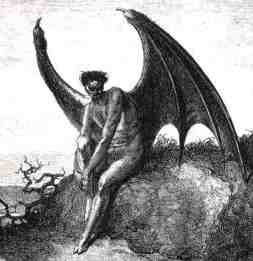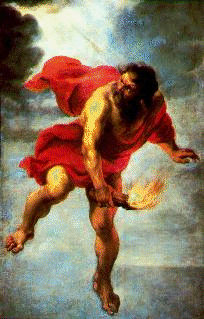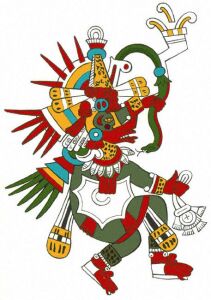Home
About Us
Bookstore
Links
Blog
Archives
Conspiracy Watch
Consumer Watchdog
Girls
In Black
Health
Heartwarmers
Paranormal
Quirky & Bizarre
UFOs
Weird
Science
Affilates
Hollywood Investigator
Horror Film Aesthetics
Horror Film Festivals
Horror Film Reviews
Tabloid Witch Awards






|
DIVINE REBELS, ALIEN DISSIDENTS!
ARE 'LUCIFER, PROMETHEUS & QUÉTZALCOATL'
A PRO-HUMAN FACTION IN THE "ALIEN RAJ"?
by C. Scott Littleton, guest contributor.
[November 5, 2003]
I am not
a ufologist. I've never investigated a UFO sighting, nor a crop circle,
cattle mutilation, or an abduction. Nor, to the best of my conscious
knowledge, am I an "experiencer." Twice, when I was young and again
a few years ago, I've observed flying objects that didn't fit any categories
with which I'm familiar.[1]
But I've never had a significant "missing time" episode or other indication
that I've been a "guest" aboard an alien ship.
Yet for
more decades than I care to remember, I've watched the serious UFO literature--including
works by investigators such as Jacques Valleé, Budd Hopkins, John
Mack, David Jacobs, Timothy Goode, Linda Moulton Howe, Jenny Randles, Raymond
Fowler, Stanton Friedman, Bruce Maccabee, the late Allen Hynek, and Don
Ecker of UFO Magazine, to mention a
few -- grow into an impressive body of data and theory. It is a literature
that can no longer be ignored by responsible social scientists, including
cultural anthropologists like myself.
Thus, I've decided to "come
out of the closet," as it were, and assert my belief that the UFO phenomenon
is real -- despite the carefully orchestrated attempts by our own and other
governments to deny its existence, and the skeptics and debunkers who do
their best to make persons who take the phenomenon seriously appear ridiculous.
The implications
of the UFO phenomenon for anthropologists -- or for anyone who would make
rational sense out of the human condition -- are profound. If Valleé, et
al. are correct, humans have been the genetically exploited "lab rats"
of one or more extraterrestrial civilizations, whose technological sophistication
(evincing Sir Arthur C. Clarke's assertion that "Any sufficiently advanced
technology is indistinguishable from magic") has allowed them to maintain
a clandestine hegemony over this planet for at least the past 13,000 years.[2]
With apologies
to the "British Raj," which held hegemony over India from the late seventeenth
century to 1947, I've come to conceive of this extraterrestrial presence
as the "Alien Raj." Yet that may be a grossly oversimplified picture
of the nature of human-alien interaction, especially in ancient times.
The "Alien Raj" seems not to have been -- and may still not be -- monolithic,
any more than was the British Raj, even in its nineteenth-century heyday.
Almost
every ancient mythology includes at least one rebellious deity, one who
willfully violates the divine "rules." For the most part, such figures
are what anthropologists call "tricksters," that is, gods or heroes who
gain their ends by cleverness, stealth, and liberal applications of magic
rather than by sheer divine power. Tricksters are typically reprimanded
and/or severely punished for their actions, which, more often than not,
involve efforts to transmit elements of divine wisdom or "technology" to
mortals.
This article
focuses on three trickster deities: (1) The Old Testament figure Lucifer,
the "Light-Bearer," who, in defiance of Yahweh, brought self-awareness
to Adam and Eve in the Garden of Eden; (2) the Greek deity Prometheus,
who rebelled against the authority of Zeus and gave fire to mankind; and
(3) the ancient Mesoamerican god Quétzalcoatl, the "Feathered Serpent,"
known to the Maya as Kukulkan, who was forced into exile because of his
efforts on behalf of mankind.
I posit
that these and other trickster deities (e.g. the Old Norse god Loki,
who built Valhalla but later turned against the supreme god Odin, and the
pan-Polynesian god Maui, for whom the island is named) are mythological
reflections of one or more extraterrestrial dissidents who rebelled against
the Alien Raj's "Prime-Directive"-type policy of non- interference in human
affairs--except when it suits the aliens' immediate agenda--and were punished
for their actions by the Raj.
* Lucifer
 The best-known,
albeit most misunderstood, of my three examples is Lucifer, the "Fallen
Angel" who rebelled against the divine authority of Yahweh and was exiled
from Heaven. Soon thereafter, disguised as a serpent, he tricked
Adam and Eve into becoming fully sentient, that is, over and above an immediate
awareness of their sexual natures. The best-known,
albeit most misunderstood, of my three examples is Lucifer, the "Fallen
Angel" who rebelled against the divine authority of Yahweh and was exiled
from Heaven. Soon thereafter, disguised as a serpent, he tricked
Adam and Eve into becoming fully sentient, that is, over and above an immediate
awareness of their sexual natures.
This violated God's policy of
"non-interference" in the newly-created humans' affairs, and Lucifer remained
an outcast as far as the supreme--and eventually monotheistic -- Hebrew deity
was concerned.
I suspect
that in this story's earliest version, Lucifer, like Prometheus, also gave
Adam and Eve the secret of fire-making, as is suggested by his name.
Note, although they were eventually conflated, Lucifer should be distinguished
from Satan, who entered the Hebrew tradition much later and is derived
from the ancient Zoroastrian entity Angra Mainyu, the "Lord of Darkness,"
who was believed to be in permanent conflict with Ahura Mazda, the "Lord
of Light and Goodness."
(This latter conflict may also reflect the
alien presence, more specifically a conflict between two or more ET species
who, some 6,000-7,000 year ago, seem to have fought what amounted to a
colonial war for possession of Earth.[3])
In the
fully developed Hebrew religious tradition, the sexual aspect of Lucifer's
"gift," together with the defiance of divine authority, assumed a disproportionate
importance, and thus, unlike Prometheus, the Hebrew "Light-Bearer" remained
a negative figure, an exile deserving his fate. Thus, ironically,
the ancient Hebrews came to interpret the mythology surrounding this pro-human
figure in much the same way the Alien Raj regarded the behavior of the
dissident who inspired it: a clear violation of the rules that could not
go unpunished.

* Prometheus
 A member
of the Titans (the elder dieties in ancient Greek tradition), Prometheus defected and sided with the younger Olympian gods, headed by Zeus.
(Again, we have the theme of an ancient conflict that probably has alien
overtones.) A member
of the Titans (the elder dieties in ancient Greek tradition), Prometheus defected and sided with the younger Olympian gods, headed by Zeus.
(Again, we have the theme of an ancient conflict that probably has alien
overtones.)
But after the Olympians defeated the Titans and banished
their leader (Zeus's father Kronos) to subterranean Tartaros, Prometheus
(whose name means "Forethought") grew uneasy with Zeus's intentions toward
the newly-created humans.
Zeus, the chief Olympian, forbade Prometheus
from carrying fire from Heaven and teaching mortals how to use it.
Prometheus defied his sovereign and did so anyway. As a result, humans
became more than mere dumb animals, just as Lucifer's "gift" permitted
Adam and Eve to emulate their creator, at least to a degree.
 Enraged,
Zeus chained the rebellious god to a mountain top, where an eagle pecked
his liver. A colleague, Elizabeth Barber, suggests that this is a
metaphor for a volcanic eruption in which the eagle's black wings are the
spreading plume of smoke and the god's blood is the red-hot lava flowing
down the mountain side. Enraged,
Zeus chained the rebellious god to a mountain top, where an eagle pecked
his liver. A colleague, Elizabeth Barber, suggests that this is a
metaphor for a volcanic eruption in which the eagle's black wings are the
spreading plume of smoke and the god's blood is the red-hot lava flowing
down the mountain side.
Her interpretation may also be correct, as
most mythology is multi-layered; once it was clear that the rebellious
gift-giver from the sky was punished, human imagination took over, and
the symbolic association of Prometheus's torment with a particularly devastating
volcanic eruption took shape.
In time,
Zeus's rage abated, and Prometheus came to occupy a heroic position in
ancient Greek religion as humanity's chief divine benefactor. This
is in stark contrast to the Lucifer myth, nevertheless, the tales are strikingly
similar. Indeed, together with R. J. Werblowksi and several other
scholars, I suspect there is a historical connection between these two
figures, and that they reflect a common Near Eastern account of a rebellious,
"light-bearing" pro-human deity who descended from the sky bearing knowledge -- technological
and otherwise -- and was punished and/ or exiled by his "divine" -- that is,
alien -- superiors for his actions on behalf of humanity.
* Quétzalcoatl
 My third
example of a "pro-human" deity that seems to derive from a dissident alien
prototype is the Mesoamerican "feathered-serpent" god Quétzalcoatl,
called Kukulkan by the Maya, who is described as a culture-bearer.
A relatively benign deity, at least by the bloody standards of Mesoamerican
mythology, Quétzalcoatl, like Lucifer and Prometheus, came to earth
to teach his human devotees all manner of useful arts and wisdom.[4] My third
example of a "pro-human" deity that seems to derive from a dissident alien
prototype is the Mesoamerican "feathered-serpent" god Quétzalcoatl,
called Kukulkan by the Maya, who is described as a culture-bearer.
A relatively benign deity, at least by the bloody standards of Mesoamerican
mythology, Quétzalcoatl, like Lucifer and Prometheus, came to earth
to teach his human devotees all manner of useful arts and wisdom.[4]
Like the other two divine rebels, by doing so, he angered his fellow gods
and was forced into exile, although vowing to return at some future time -- a
motif implicit in the other two mythologies (Prometheus returned after
Zeus pardoned him, and Lucifer's eagerness to return, albeit negatively
valued, permeates the Judeo-Christian tradition).
Two elements
of the Quétzalcoatl mythology are relevant. First, his "feathered-serpent"
image. Several UFO abductees, including Nebraska Highway Patrolman
Herbert Schirmer and Betty Andreessen-Luca, have reported seeing winged
serpents emblazoned on the abductors' uniforms. Although this element
is absent in the Lucifer and Prometheus mythology, Lucifer's reptilian
alter ego in the Garden of Eden is noteworthy, and the winged-serpent figure
does exist in ancient Greek tradition in the image of the Caduceus (although
it's associated with Asclepias, god of medicine, rather than with Prometheus).
Nevertheless,
I suspect the image of a winged or feathered serpent is an important and
deep-rooted alien symbol, one that may reflect a very ancient extraterrestrial
totemic identification that predates the Alien Raj. Thus, one may
expect both dissidents, like the prototype of Quétzalcoatl, and
the more "establishment" type aliens who abducted Schirmer and Andreasson-Luca,
to display it.
The second
relevant element in the Quétzalcoatl mythology is the idea that
he is fair-skinned. This was one reason Moteczuma initially accepted
Hernándo Cortes as Quétzalcoatl redux.[5]
(Among the alien physical types reported by abductees are the so-called
"Nordics": blond, blue-eyed humanoids who sometimes appear in charge.[6])
Although Cortes and his fellow Spaniards didn't entirely match this human
type, the dissident alien prototype of Quétzalcoatl could have been
a Nordic, and the fact that the Europeans were generally fairer than Mexicans
may have led Mocteczuma and his people to believe that the god had returned.
Of course, they soon realized that Cortes and his rapacious comrades were
far from divine, but by then it was too late; the Conquest was a fait
accompli.
This may
be a lesson for us humans, especially for those "New-Agers" who have seen
fit to deify our alien colonial masters.

* Rebel God and Alien Prototype(s)
We have a
pattern: A divine being (Lucifer, Prometheus, Quétzalcoatl, and
other trickster figures) defies his superiors in the pantheon (Yahweh,
Zeus, Huitzilopochitli) and attempts to assist humans. After transmitting
some divine lore (self-awareness, the secret of fire-making, writing, etc.)
he is punished by his superiors, either physically or by exile. It
seems extremely probably that this widespread theme reflects an actual
event (or series of events) of some 5,000-odd years ago, one that involved
an abortive rebellion against the non-interference policy of the Alien
Raj.
Do alien
dissidents still exist? One can only wonder, although some abductees/contactees
do report being given information that has proven useful. My friend Jack
Sarfatti, a post-quantum physicist, asserts that he received an alien
"phone call" in 1953 which predicted that he'd make an important breakthrough
in 1973. And it happened. Could this phone call have been made
by an heir to Prometheus or Quétzalcoatl?
If a dissident
movement persists within the Alien Raj, we must contact it and obtain some
of that magical technology, and the science behind it. It would appear
to be the only realistic way to consider overthrowing the Raj's oppressive
hegemony. Only when we discard the notion that our extraterrestrial
"visitors," as Whitley Strieber has dubbed them, exist on some higher "spiritual
plane" than ourselves can we make rational sense of a phenomenon that has
such a profound, albeit clandestine, impact on our existence.
As yet,
no hard, incontrovertible evidence exists that my three divine "suspects"
were mythological reflexes of ancient alien dissidents. But I submit
that the "soft" evidence supporting both the presence of an Alien Raj,
and my above hypothesis, is persuasive enough to warrant close collaboration
between anthropologists specializing in comparative mythology and folklore,
and serious students of the UFO phenomenon.
We anthropologists
must overcome the "they shouldn't exist, therefore they don't exist" skeptical
mindset frequently encountered in academia, and systematically examine
UFO abductee accounts and their congruence with mythology and folklore.
| * Recommended
Reading from C. Scott Littleton ...
The literature on Lucifer, Prometheus, and Quétzalcoatl is vast.
For an interesting discussion on the parallels between Lucifer and Prometheus,
see R. J. Zwi Werblowsky's Lucifer
and Prometheus: A Study of Milton's Satan.
A succinct discussion
of Quétzalcoatl appears in Roy Willis's World
Mythology, pp. 240-241. Info on the "feathered serpent" as alien
insignia appears in Ralph Blum and Judy Blum' s Beyond
Earth: Man's Contact with UFOs, p. 113 (the Schirmer case), and Raymond
Fowler's The
Andreasson Affair.
For David M. Jacobs's take on the "Nordics,"
see The
Threat: Revealing the Secret Alien Agenda, p. 132. For Jack Sarfatti's
1953 telephonic "encounter" with a pro-human alien, see his book Destiny
Matrix.
The full text of Charles Fort's observation about Earth
being the object of an alien "colonial war" is quoted by George C. Andrews,
in Extra-Terrestrials
Among Us, p. 106. |


An alien
dissident
falls in
love with her
abductee
in C. Scott
Littleton's Phase
Two.
|
C. Scott Littleton
...
... is Professor
of Anthropology, Emeritus, at Occidental College, Los Angeles, CA.
He applies
his anthropological knowledge to speculate about an alien dissident falling
in love with her abductee in his new novel, Phase
Two.
He has a personal
website and email: yokatta@oxy.edu.
He is also
author or editor of such scholarly books as:
From
Scythia to Camelot: A Radical Reassessment of the Legends of King Arthur,
the Knights of the Round Table, and the Holy Grail,
Shinto:
Origins, Rituals, Festivals, Spirits, Sacred Places,
Mythology:
The Illustrated Anthology of World Myth and Storytelling,
The
New Comparative Mythology: An Anthropological Assessment of the Theories
of Georges Dumezil,
Eastern
Wisdom: An Illustrated Guide to the Religions and Philosophies of the East
(Henry Holt Reference Book),
The
Sacred East: Hinduism, Buddhism, Confucianism, Daoism, Shinto, and
Understanding
Shinto: Origins, Beliefs, Practices, Festivals, Spirits, Sacred Places. |
| * Footnotes
...
1.
Circa 1936 or 1937, when I was three or four years old, I watched what
I later came to think of as a "flying French horn"--this was at least a
decade before the phrase "flying saucer" entered the lexicon--drift slowly
across my nursery window after waking up from an afternoon nap. A
half-century later, in March of 1990, while vacationing at the southern
tip of Baja California, I woke up at 3:00 a.m. one morning and watched
a bright point of light perform a variety of maneuvers over the ocean,
including 90-degree turns, that no aircraft I'm aware of can perform.
After about three minutes, just as I was about to wake up my wife, the
object simply winked out.
2.
Exactly how long the aliens have been here is still an open question.
The appearance of lenticular, or discoid images on cave walls in Southern
France and elsewhere in the late Upper Paleolithic (ca. 13,000 years ago),
lends credence to this date, but their arrival could have been earlier--perhaps
as far back as 25,000 years ago if some ambiguous African petroglyphs are
depictions of alien beings. Some investigators assert aliens have
been here for hundreds of thousands of years, and were responsible for
hominid evolution, or at least that of anatomically modern Homo sapiens. However, other researchers, such as David Jacobs (personal communication),
assert that the alien presence hardly dates back more than a century.
3.
Except perhaps to say that Charles Fort's eighty-odd-year-old observation "That
once upon a time, this earth was No-Man's land, that other worlds explored
and colonized here, and fought among themselves for possession..." now
appears remarkably prescient!
4.
There may be a purely historical dimension to some of the mythology surrounding
the "Feathered-Serpent." We know that a brilliant Toltec prince named
Topilzin Quétzalcoatl, who reigned at Tula (ca. A.D. 850-900) and
is credited with introducing a variety of useful arts and knowledge, was
removed from power by a jealous faction in the ruling dynasty and forced
into exile.
5.
Additionally, by sheer chance, the year in which the Conquistadores arrived,
1519, marked the end of a 52-year Aztec calendric cycle, at which time
miraculous events were supposed to happen, including the return of figures
like Quétzalcoatl.
6.
My own view here coincides with that of David Jacobs, who suspects that
the Nordics are more probably what he calls "late-stage" human-alien hybrids,
and thus not the dominant alien species. Nevertheless, they do seem
fully integrated into the Alien Raj, at least culturally, and it's not
impossible to suggest that one or more of them became disenchanted with
"establishment" policy re the "natives" and rebelled against the Raj. |
Copyright 2003 by C. Scott Littleton.
A slightly different version of this article initially appeared in UFO
Magazine [April/May 2002].

|
